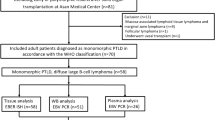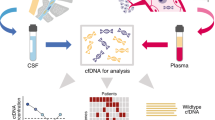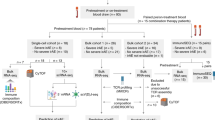Abstract
Circulating Epstein–Barr virus (EBV) DNA is a biomarker of EBV-associated malignancies. Its significance in natural killer/T-cell lymphoma treated with the novel regimen SMILE was investigated. EBV DNA was quantified with a World Health Organization EBV standard in 910 plasma samples collected during 230 courses of SMILE in 56 patients. Median presentation EBV DNA was 1900 (0–1.4 × 107) IU/ml. Presentation EBV DNA was significantly associated with tumor load and treatment response. To examine lymphoma chemosensitivity, EBV DNA changes after SMILE were evaluated. EBV DNA after SMILE (I) significantly correlated with tumor load and treatment response. Two dynamic parameters were further analyzed: negative EBV DNA after SMILE (I) and EBV DNA change patterns during treatment (A: persistently undetectable; B: persistently detectable<presentation; C: persistently detectable>presentation). Negative EBV DNA after SMILE (I) and pattern A EBV DNA change significantly correlated with lower tumor load and superior outcome. Multivariate analysis involving presentation features, international prognostic index (IPI), Korean prognostic score and EBV DNA parameters showed that negative EBV DNA after SMILE (I) had the most significant impact (P<0.001) on overall survival and pattern A EBV DNA change had the most significant impact (P=0.002) on disease-free survival. Presentation EBV DNA, IPI and Korean prognostic scores were not independent prognostic factors.
This is a preview of subscription content, access via your institution
Access options
Subscribe to this journal
Receive 12 print issues and online access
$259.00 per year
only $21.58 per issue
Buy this article
- Purchase on Springer Link
- Instant access to full article PDF
Prices may be subject to local taxes which are calculated during checkout


Similar content being viewed by others
References
Chan JK, Quintanilla-Martinez L, Ferry JA, Peh SC . Extranodal NK/T-cell lymphoma, nasal type. In: Swerdlow SH, Campo E, Harris NL et al. (eds) WHO classification of tumours of haematopoeitic and lymphoid tissue. International Agency for Research on Cancer: Lyon, 2008; pp 285–288.
Chan JK, Jaffe ES, Ralfkiaer E, Ko YH . Aggresssive NK cell leukaemia. In Swerdlow SH, Campo E, Harris NL et al. (eds) WHO classification of tumours of haematopoeitic and lymphoid tissue. International Agency for Research on Cancer: Lyon, 2008; pp 276–277.
Kwong YL . Natural killer-cell malignancies: diagnosis and treatment. Leukemia 2005; 19: 2186–2194.
Ishida F, Kwong YL . Diagnosis and management of natural killer-cell malignancies. Expert Rev Hematol 2010; 3: 593–602.
Yamaguchi M, Suzuki R, Kwong YL, Kim WS, Hasegawa Y, Izutsu K et al. Phase I study of dexamethasone, methotrexate, ifosfamide, L-asparaginase, and etoposide (SMILE) chemotherapy for advanced-stage, relapsed or refractory extranodal natural killer (NK)/T-cell lymphoma and leukemia. Cancer Sci 2008; 99: 1016–1020.
Yamaguchi M, Kwong YL, Kim WS, Maeda Y, Hashimoto C, Suh C et al. Phase II study of SMILE chemotherapy for newly diagnosed stage IV, relapsed, or refractory extranodal natural killer (NK)/T-cell lymphoma, nasal type: the NK-Cell Tumor Study Group study. J Clin Oncol 2011; 29: 4410–4416.
Kwong YL, Kim WS, Lim ST, Kim SJ, Tang T, Tse E et al. SMILE for natural killer/T-cell lymphoma: analysis of safety and efficacy from the Asia Lymphoma Study Group. Blood 2012; 120: 2973–2980.
Lo YM . Quantitative analysis of Epstein-Barr virus DNA in plasma and serum: applications to tumor detection and monitoring. Ann N Y Acad Sci 2001; 945: 68–72.
Fryer JF, Heath AB, Wilkinson DE, Minor PD . the Collaborative Study GroupCollaborative study to evaluate the proposed 1st WHO international standard for Epstein-Barr Virus (EBV) for nucleic acid amplification technology (NAT)-based assays). http://www.who.int/biologicals/expert_committee/BS2011.2172Epstein_Barr_Virus.pdf (accessed on 26 January 2013).
National Institute for Biological Standards and Control. WHO International Standard. 1st WHO international standard for Epstein-Barr Virus for nucleic acid amplification techniques NIBSC code: 09/260. Instructions for use (Version 2.0, Dated 12/01/2012). http://www.nibsc.ac.uk/documents/ifu/09-260.pdf (accessed on 26 January 2013).
Lee J, Suh C, Park YH, Ko YH, Bang SM, Lee JH et al. Extranodal natural killer T-cell lymphoma, nasal-type: a prognostic model from a retrospective multicenter study. J Clin Oncol 2006; 24: 612–618.
Chim CS, Ma SY, Au WY, Choy C, Lie AK, Liang R et al. Primary nasal natural killer cell lymphoma: long-term treatment outcome and relationship with the International Prognostic Index. Blood 2004; 103: 216–221.
Ito Y, Kimura H, Maeda Y, Hashimoto C, Ishida F, Izutsu K et al. Pretreatment EBV-DNA copy number is predictive of response and toxicities to SMILE chemotherapy for extranodal NK/T-cell lymphoma, nasal type. Clin Cancer Res 2012; 18: 4183–4190.
Kim HS, Kim KH, Kim KH, Chang MH, Ji SH, Lim do H et al. Whole blood Epstein-Barr virus DNA load as a diagnostic and prognostic surrogate: extranodal natural killer/T-cell lymphoma. Leuk Lymphoma 2009; 50: 757–763.
Suzuki R, Yamaguchi M, Izutsu K, Yamamoto G, Takada K, Harabuchi Y et al NK-cell Tumor Study Group. Prospective measurement of Epstein-Barr virus-DNA in plasma and peripheral blood mononuclear cells of extranodal NK/T-cell lymphoma, nasal type. Blood 2011; 118: 6018–6022.
Au WY, Pang A, Choy C, Chim CS, Kwong YL . Quantification of circulating Epstein-Barr virus (EBV) DNA in the diagnosis and monitoring of natural killer cell and EBV-positive lymphomas in immunocompetent patients. Blood 2004; 104: 243–249.
Acknowledgements
The authors thank Stanley Yeung for assistance in statistical analyses.
Author contributions
YLK designed the study, treated the patients, wrote and approved the manuscript. AP designed the study, performed the experiments, wrote and approved the manuscript. AYHL treated the patients, wrote and approved the manuscript. CSC treated the patients, wrote and approved the manuscript. ET treated the patients, wrote and approved the manuscript.
Author information
Authors and Affiliations
Corresponding author
Ethics declarations
Competing interests
The authors declare no conflict of interest.
Additional information
Supplementary Information accompanies this paper on the Leukemia website
Rights and permissions
About this article
Cite this article
Kwong, YL., Pang, A., Leung, A. et al. Quantification of circulating Epstein–Barr virus DNA in NK/T-cell lymphoma treated with the SMILE protocol: diagnostic and prognostic significance. Leukemia 28, 865–870 (2014). https://doi.org/10.1038/leu.2013.212
Received:
Revised:
Accepted:
Published:
Issue Date:
DOI: https://doi.org/10.1038/leu.2013.212
Keywords
This article is cited by
-
Liquid biopsy in T-cell lymphoma: biomarker detection techniques and clinical application
Molecular Cancer (2024)
-
How we treat NK/T-cell lymphomas
Journal of Hematology & Oncology (2022)
-
Estimating the global burden of Epstein–Barr virus-related cancers
Journal of Cancer Research and Clinical Oncology (2022)
-
Bilateral deafness in NK/T-cell lymphoma: EBV DNA prevailed over magnetic resonance imaging
Annals of Hematology (2022)
-
NK-/T-cell lymphomas
Leukemia (2021)



